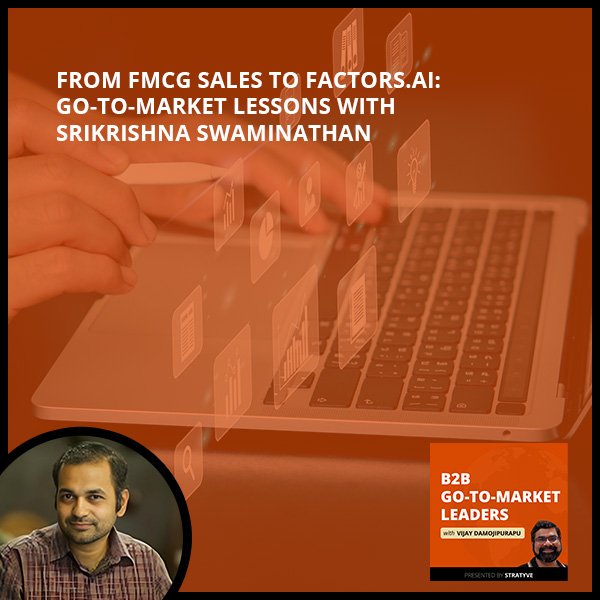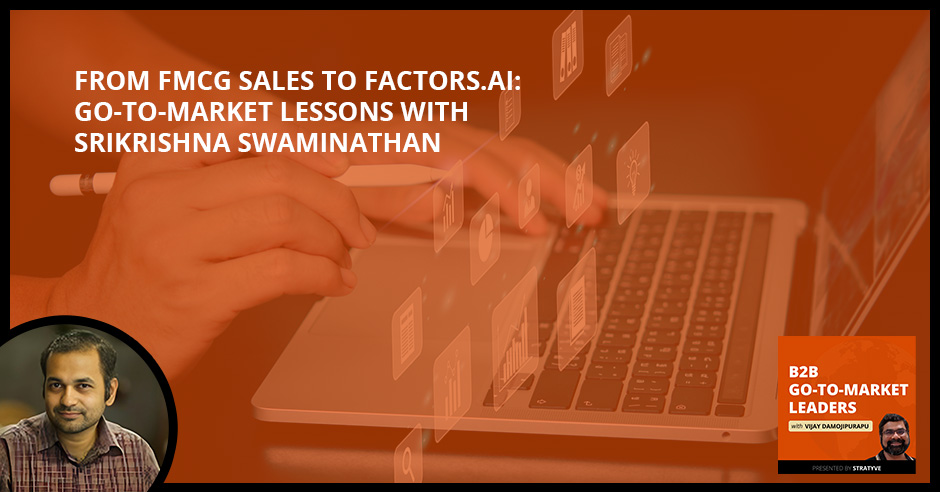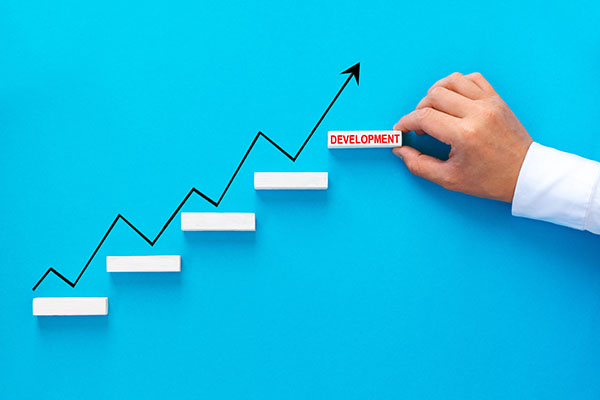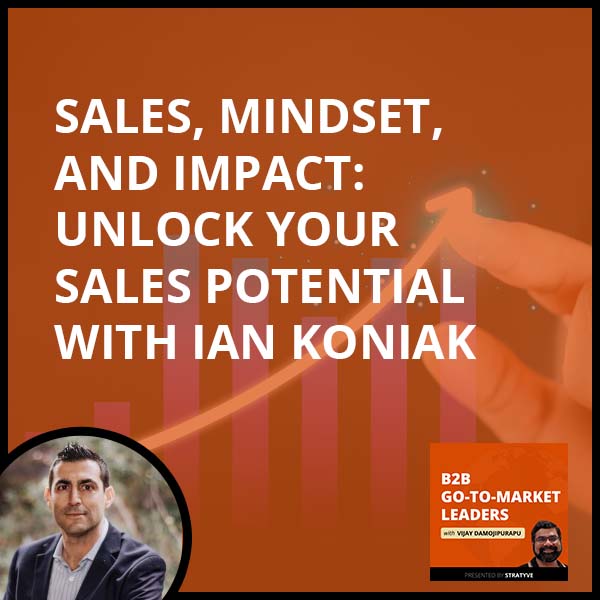
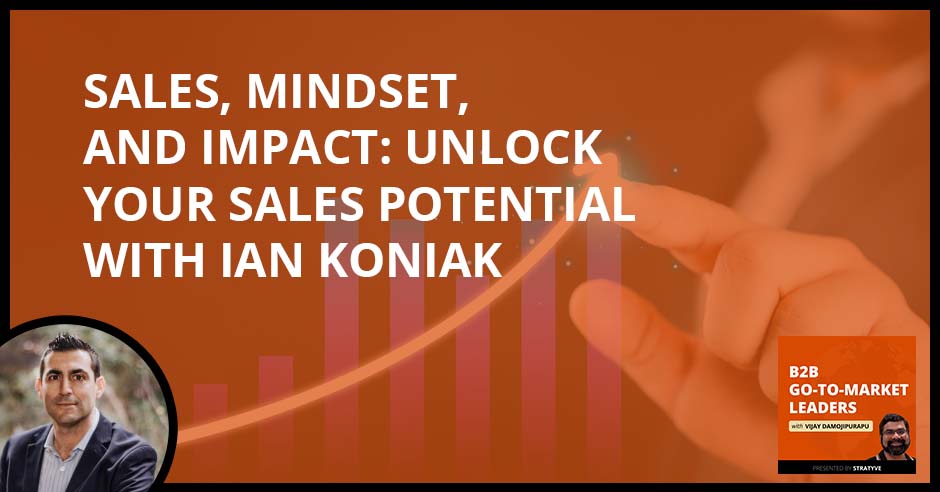
Success isn’t just about selling more; it’s about becoming more. In this episode, we tackle all about sales, personal growth, and entrepreneurship with Ian Koniak, CEO and Founder of Unlock Your Sales Potential. Ian generously shares his go-to-market strategy for his coaching program and reveals the three levels of offerings that have driven his business to over two million dollars in just a few years. But as a founder, Ian’s mission goes beyond just boosting sales; he’s all about helping clients become the best versions of themselves. Ian’s approach to business and life can transform not only your sales game but also your overall well-being. As Ian advises in the episode, “Enjoy the ride and make it about other people.” Tune in now and unlock your potential both in sales and personal growth.
—
Listen to the podcast here
Sales, Mindset, And Impact: Unlock Your Sales Potential With Ian Koniak
Thank you once again for taking the time to tune in to this show. It is deeply appreciated. I am deeply grateful for you taking the time and tuning in to this. I have yet another wonderful guest. His name is Ian Koniak. He is the Founder and CEO of Untap Your Sales Potential. As the name implies, he’s a sales guru or sales expert. Without further ado, welcome to the show, Ian.
Thank you. Thanks for having me on. It’s nice to meet you.
Same here. Sales is top of mind for me, for go-to-market practitioners, and for founders, and it’s a critical skill. I’m excited and looking forward to really digging into this topic with you.
I can’t wait. Let’s go.
Let’s get going into the meat of the conversation which is all about how you view and define the go-to-market.
When you think about go-to-market, it’s all of the forces that lead to revenue. When I think about go-to-market, I think about what your distribution channel is. In other words, are you going to sell directly? Are you going to sell through resellers? Are you going to sell online? Are you going to sell in stores? What’s your channel?
I’ll give a brief background. When I started my company, it was several years ago. I was doing a lot of training for companies. I was going to do B2B and I was going to sell training services. I quickly realized that didn’t scale because I was doing the training and I didn’t want to be on the road all the time. There was only so much capacity.
Even if I was doing all the training and potentially hiring other people to help, which they not necessarily give the same level of training that I would having been in the field for twenty years, there was still a cap on growth. That go-to-market strategy was a B2B live training delivery. I shifted. It’s the delivery of the product. It’s the distribution of the product. It’s the marketing of the product. It’s the pricing strategy. It’s all of it.
When I think about go-to-market, it is how you market your products, how you find customers, how you acquire customers, how you serve customers to make sure they renew, how your product specifically meets a unique need in the market, and how you market and position your value proposition so that you are differentiated versus a crowded space in almost any market. That’s how I define go-to-market strategy.
Back to my story, I started with B2B where I was doing live training. I quickly shifted that to delivery online through coaching programs and online courses that scaled at a much greater capacity. I didn’t want a go-to-market strategy that relied on me having to do the work versus being able to build repeatable processes that could attract a lot more people and have them do the work, for example.
You touched upon several key aspects. There is the product piece. In your case, it’s the services and the training, and then how you price it. Who is it really for? What is the value prop, the marketing, the sales, the outreach, and so on? It’s the scaling piece. Something else that you also touched upon is the founder of the entrepreneurial aspect of it. Especially in early-stage companies, it doesn’t matter if it’s a product or service. Those go-to-market principles matter a lot. We’ll dive into those aspects, for sure.
There’s a great book, E-Myth Revisited, that I’m reading. As a founder, you went to a business because you didn’t want to depend on corporate to pay your bills. You didn’t want to have to be beholden to a company or a boss. If you’re a founder and then you’re beholden to your business and your business is controlling you, it’s very easy to repeat the same type of patterns that you had when you were an employee.
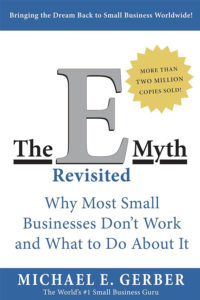
For me, the go-to-market is all about constantly re-evaluating your business, adapting, and changing strategies. I’ve changed strategies in four years since I originally founded my company. I’ve changed strategies 4 or five 5, but it wasn’t like I pivoted completely. I made small pivots that got me towards more of what I wanted. Knowing what you want as the founder, knowing what your goals are, and knowing what you’re trying to deliver to the market is something that constantly needs to be re-evaluated and optimized on an annual basis. That’s important for a founder to think through as well.
For sure. I can relate to it firsthand. I was an employee until about a few years ago. I pivoted into starting my own go-to market. Even within marketing and go-to-market, it was specifically around the product marketing aspect. I had to pivot, so I can relate to a lot of what you’re saying. Early on, it was me wearing multiple hats and I was drowned. This is exactly why I want to escape that whole employee constraint and jailhouse. This time, it’s all about bringing in the right people, even delegating and hiring junior employees for the right things, helping you scale, and addressing the key issue.
That’s exactly right. That’s the point. If you’re the founder who’s doing everything, you are going to do nothing well. Where is your greatness? Delegate and outsource the rest. I have a team of eight people that are supporting me in different capacities. It frees me up to deliver the coaching and deliver the work itself versus having to sell the work and market the work. Even content creation is a huge endeavor for how I attract customers.
If you're the founder who’s doing everything, you're going to do nothing. Share on XThe development of my platform for delivering the actual training itself, all of that’s outsourced. In the beginning, I was doing it. The reason I pivoted is I realized I was creating the invoices for the client. I was creating the content. I was creating the training. I was delivering the training. It was like, “This does not scale at all. It’s not something I want to be in.” I got out of that B2B business a few years ago and pivoted. The business is on track to be an Inc 5000 company by 2024. It has been the best change ever.
As a founder, are you happy? Are you in control? If not, what do you need to change? Who do you need to hire? Maybe you need to take fewer clients. Maybe you need to charge more so that you’re not running ragged. These are all things that I’m thinking about very actively. In January 2024, I’m going to change our entire model again, but it’s not like I’m moving away or abandoning the original vision. The original vision is exactly the same. It’s more about the delivery of that and the scaling and the pricing model. Those things are how I pivot.
I love the fact of how deep we got into that one topic, which is how you view and define go-to-market. It is similar to a product. When you build a product, you need to iterate B1, B2, and so on. It’s the same thing that applies to go-to-market as well. Let’s take a step back here and go bigger picture. Share with the audience as to what brought you to what you’re doing. What is your career story?
I worked at two companies. I sold tech for twenty years. I was an Account Director over at Salesforce, which means I was in charge of growing our largest enterprise accounts. I managed accounts like Activision Blizzard, Experian, Tencent, some pretty large brands for Berkshire Hathaway, and some big brands for Salesforce. I was responsible for selling. I carried my last year with about $20 million in annual revenue. I was managing. I had a team of specialists, engineers, and resources. I was very successful in that space. I made all the clubs and had all the accolades. I made great money.
In 2018, I had a near-death experience. It was a very unique experience. I’ll keep it short. I got stuck on a rollercoaster hanging upside down for 30 minutes. It was pretty gnarly. In that moment of hanging, I thought all of our weight was on this little strap. We were upside down. I thought I was going to tumble. We were about eighteen stories up. We were up 180 feet and I was staring down with one little bar. I was completely stopped. I thought the bar was going to fall or whatever. I didn’t know. It was the scariest moment of my life.
I’m feeling nervous listening to this. I can imagine what you were going through.
It was horrible, but it was also one of the best things that’s ever happened to me. The reason is because in that moment hanging, you have a lot of time to reflect on your life. Your life flashes before you when you think you’re going to die. Those chemicals are rushing through your brain. What I came to was this massive epiphany as I was hanging that my life had been meaningless.
Your life literally flashes before you when you think you're going to die. Share on X
I certainly had worked hard. I certainly had done well at work and had a family. I loved my wife and my son at the time. Now, we have two kids, but at the time, we only had one son. It was like, “If I died now, my entire life would’ve been dedicated to the pursuit of my own ego, my own money, and my own success.” It was all external. It was all about things that I was chasing that were external to me. In other words, there was no legacy, no service, and no impact. It’s like, “What?”
I had all these gifts that I’ve been blessed with. I had the gift of passion, drive, perseverance, resilience, and all these things that made me successful in sales. Yet, I was keeping them to myself solely to make money and sell. It’s that selfish, greedy salesperson. That stereotype, I probably fit that. I didn’t say anything. I started praying. I said, “God, please get me down. I promise I’ll start serving other people. I’m not going to be greedy and selfish. I’m going to use the gifts that You’ve given me to help others.” Nothing happens and I’m like, “God, I’m going to do it right now. Get me down.” At that moment, I kid you not, the ride started going down. When I got down, I was like, “I got to promise to uphold it.”
It was a very spiritual experience for me to have that divine intervention where I realized that my life had been very self-serving and I needed to start giving to others. I got off the rollercoaster and didn’t decide to start Untap Your Sales Potential, but I did decide to start serving other people and share my knowledge, wisdom, and experience with other people. It started with me setting up an Instagram page, then a YouTube channel, then a newsletter, and then some other content. I started speaking at events. I started going on podcasts to give back and help other people.
I was the number one sales rep at Salesforce at the time. A lot of people wanted to know how I could sell millions per year. That was where it all started. It was this desire to help. That evolved into people wanting more than content. They wanted consulting. They wanted coaching. They offered me money. It was like, “Wait a minute.”
One thing led to another and the demand became so high that I eventually left corporate. It made a lot of sense to do something that benefited others and helped society. I could be financially free from depending on other people for my quota, my commission rates, and all the things that salespeople struggle with. When they do well, they raise the quote on you. They lower the commission. They take away your territory. All that was happening while I had this side hustle. I knew that it was time to take the leap. That’s how I got started.
Thank you so much for sharing that story. It’s critical. At some point in time in life, it happens not for all but hopefully, for many. It is that you question whether what you’re doing is “the right thing”. You’re like, “Is it only about me, my family, my money, and my selfish needs?” versus where is that service? Where is the impact? Where is the legacy piece?
I wish everyone would have a near-death experience for this reason because you really think about your life. There are a lot of great books out there that reference this concept. One of them is The 7 Habits of Highly Effective People. In that book, Stephen Covey has you write your own speech at your own funeral. That’s an exercise that’s very eye-opening and powerful because would you have contributed to the world? Would you have followed that dream that you thought about? Did you take a chance or play it safe? These are things that if you’re a founder, you have, at some point, had some of these eye-opening realizations.
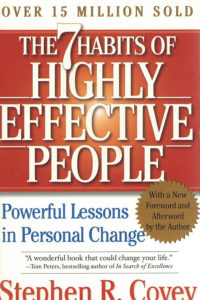
Founders are a small percentage of the population. I’d encourage anyone if you have that calling or have that dream to act on it. You don’t need to quit tomorrow. You don’t need to drop everything. Start taking action in serving or helping the person that you once were, in other words, making your message, and helping others like you get past the challenges that you had. When you do that, the world opens up. Opportunities open up and the financial path reveals itself, but you have to take that first step. You can’t keep that as a dormant part of you. I wish that no one gets hurt, but I wish that people come with that type of eye-opening experience that I got to go through a few years ago.
There was something that caught my attention and I want to highlight this for the readers out there. Your approach was not like, “I’m going to quit Salesforce and I’ll figure out what I want to do in terms of legacy and service.” You started putting content out there on Instagram and others around the expertise that you’re known for, which is sales and meeting quota.
Here’s the interesting thing. What I did that first year in 2019, I had no intention of monetizing it. I wanted to start serving people and teaching them what I knew, so it was completely free. I wasn’t doing it out of a selfless go-to-market strategy of promoting my business. This time, it’s very different in terms of my content creation strategy. At the time, it was like, “I’m going to make one video every day.” I said, “I don’t care what it takes, I’m going to make one short video giving a tip of the day.” That’s how I started.
Instagram is not where my ICP lives. My ICP lives on LinkedIn. These are high-performing, high-paid tech sales professionals who use my program or companies that want to train their teams. Fundamentally, I was in the wrong place for clients. Therefore, I didn’t get clients. What I got after a year of posting every day was I got good at being on camera, communicating, and writing.
That translated ultimately when I shifted to LinkedIn. I already had a year of experience doing the strategy that ultimately became one of my go-to-market strategies. It was to create value-added content to bring people into your funnel and attract them to your services. That was the blessing and the gift of giving. I became good at marketing ironically. I make videos for a living. I go on camera and do these newsletters.
By the time I got to LinkedIn, my stuff was blowing up very quickly because I had a year of experience in practicing how to title a video, what to speak to, how to prepare it, and even getting the lighting and the sound right. It works out. Even if you don’t see it, the key is to stay on the path because everything you do in every part of your life is going to serve you in the future even if it doesn’t feel like you know exactly how.
It’s critical that you do it to the best of your ability and embrace where you are because that will come back. Especially as a business owner, all of those skills ended up helping me a lot, even teaching. I was a teacher before I got into sales. I lived in South America and taught English. This time, I’m teaching sales. It all comes back.
It’s all coming back together. What is your routine like? You highlighted that at a very high level. Let’s say you need to prepare a video for LinkedIn, Instagram, or whatever. It’s a 1 to 2-minute video. What is your routine and mindset like?
They’re longer videos. I’m doing a long format. In my first year, I was doing these Instagram Shorts, Reels, or whatever they’re called. This time, I do training videos. That’s one very small part of my go-to-market strategy, but it’s one that’s been consistent and I still do. It’s simple. I’ll give you the routine for preparing the content, and I’ll give you the routine for distributing the content and how it all feeds into the sales growth.
Preparing the content is very simple. It is whenever I have inspiration, whether it’s on a run, whether it’s talking to my wife, or whether I’m talking to a client and they tell me something that I’m like, “This is the third time I’ve heard this. I need to make a video on it.” I’m always tuning into content creation ideas. What I do is on my iPhone, because inspiration can strike anywhere, I have one note. Every time I get an idea, it’s like, “Make a video on this.”
I have one that’s ready and teed up. The title of the note is Sales Trainings. I have, “What Is the Meaning of Life?” It’s powerful. I then have in the notes, “Make the most of what God gave You.” It’s putting your gifts, your stories, and your experience to the service of others. I’m going to talk about how you can do that and give a framework for how other people can do that. That’s the first step. It is to capture the idea.
The second step is before I make the video, I’ll take a sticker and an index card and write the key points in the video. I’m not scripting a video. I’m writing the bullets I want to cover because I want them to be authentic. I want it to be a natural. There’s then the filming of the video in which you have to get the lighting right and you want to get the sound right. That’s pretty standard. You could do it on the iPhone. Get a little tripod, a mic, and a ring light and you have everything you need to make a professional-quality video.
It’s then the distribution. Here’s where the tricky thing comes in. One video can be used multiple times. That’s the beautiful thing. What I’ll do is make this video. I’ll record it typically towards the end of the week. I’ll block off time to make the video. Once it’s made, then I’ll write a blog that accompanies the key pillars that I talk about in the video. I won’t tell them everything. I’ll tell them enough and say, “Watch the video if it resonates with you.” I’ll tease it out.
That blog goes into a content document that my virtual assistant grabs and posts to a newsletter that has over 10,000 subscribers, a YouTube channel that also has almost 5,000 subscribers, LinkedIn, and a blog page. I created it once and it’s distributed in four places. There’s the blog because it drives SEO. If someone types the topic, it will drive the SEO traffic. There’s YouTube because that’s a whole channel where a lot of people live and consume my content. LinkedIn is by far the biggest.
Everything’s pointing them to the YouTube video. In the newsletter, I want them to click and watch the video. On LinkedIn, I want them to click and watch the video. In the blog, it’s the same thing as well as YouTube itself. There’s the blog, YouTube, LinkedIn, and email newsletter. I have four distribution channels that all got hit up. If they’re not on LinkedIn and they don’t see that post, they’re going to see the email. If they don’t see the email, they’ll see the popup on YouTube. You want to publish once and distribute many places, but it doesn’t stop there.
I have a video editor that slices up the long-form video and does two shorts from it. We have two more short videos on my YouTube channel. If they didn’t see the main one, they could see those shorts. Those shorts are also distributed via my Instagram page and my TikTok page, which I’ve never logged into. With all this content, I don’t want to be on social media. I don’t want to be messing around there. I want to be delivering my coaching services.
I have a VA who is setting up the distribution. I have a video editor who’s making these shorts and distributing them to TikTok and Instagram all from about an hour it took to write the video, record it, and then put it into this folder where the VA grabs it. That’s how you scale content creation. What happens naturally is people start watching my video.
There is one more thing. Anyone who requests a connection request from me on LinkedIn, which is my main source of traffic and my main thing, or anybody who connects with me, my VA sends a standard message to them. It says, “Thanks for requesting to connect. If you’re looking to grow sales, there are two ways I can help you. Number one is to subscribe to my newsletter. You get a free training video every single week every Tuesday morning. There’s also my YouTube. If you want to see the past archive, here it is. Subscribe there.”
I have over 50,000 connections on LinkedIn and all of them are also getting this. Maybe 1/10 of them subscribe and my newsletter is 10,000 as well as my video. It’s this constant flywheel that is created from this content strategy. That’s how I’ve gotten most of my clients. It drives them to book a call. When they get the newsletter, they have a welcome series. They get to book a call. They learn about the program. The audience-building has been my dominant strategy for this.
What you shared are the tactics and the mechanics of what you do. Something I want to go big picture and highlight over here is if you rewind and go back a few years, you didn’t have any clue about doing all these things. You didn’t know what you were going to do. What drove you to do the aspiration and the mindset of giving guided you into learning.
It forced me. It was not a decision. Forced is a good word. I was powerless. It was all I could think about in the shower when I woke up. It was a calling. If you’re a founder and you have a calling, if you let that calling guide you, when the why is strong enough, AKA, “I don’t want to die with being selfish and not giving back to the world,” then the how is going to reveal itself. It’s all about keeping that fire burning. That’s why I still do podcasts.
My work has fortunately gone very well where my supply-to-demand ratio, and we can talk about this, is completely off where I have more demand than I can supply because I’m the bottleneck in delivering this stuff. The same problems come to repeat themselves even if you change the strategy. It’s a good problem to have. It’s coming from a place of service.
Every time I’ve come from a place of service and try to make clients successful, the clients have naturally gravitated because they see that heart of intention versus a heart of like, “This is for us, not for you.” If people feel that in sales or they feel that from a founder, they’re going to not want to work with you. People don’t care how much you know until they know how much you care. That’s first and foremost. You have to care about the success of your clients as a core tenant for your business.
You have to care about the success of your clients as a core tenet for your business. Share on XLet’s maybe come down into more of your services aspect. Who are your ICPs, and what are your offers and services like?
My business is a coaching business. Think about a B2C model. Primarily, that’s the bulk of my revenue. Occasionally, I’ll do B2B, but the bulk is B2C. My ICPs are tech salespeople who are making between $100,000 and $300,000 per year and want to get to the elite level of sales and make between $500,000 and $1 million.
They’re struggling with how to make the leap from a transactional seller to a strategic seller. They’re struggling with time management and how to prioritize and plan their day. Their day tends to overtake them. They’re struggling with mindset, how to stay in the game, and how to stay focused and driven in an industry that can be exhausting, demanding, and stressful. Those are the people that I serve.
I’m curious. The ICP that gravitated towards you and you gravitated towards were the people who made $300,000 to $500,000 and who are looking to graduate and go even higher into the business club and so on. What about those sellers who are very green or founders who are looking to build and improve their sales skills to build in pipeline and revenue?
I don’t serve a lot of founders in general. I can, but it’s more about advisory services. If a founder wants to learn to sell and learn the basics of strategic selling, how to put together a proposal, and how to negotiate, they can take my course. The founder has to run the business. They have to know how to hire, put the right people in place, manage delivery, and manage marketing. They’re wearing so many hats as a founder.
If they want to learn the fundamentals and basics of sales, that’s probably not my program. My program is more geared towards strategic selling. In other words, you’re selling a very large ticket item. You’re selling something that’s transformational in nature. I have a lot of people from Google, Microsoft, and Salesforce. That’s the green founder.
If you’re a founder and you don’t have any sales skills, you’re going to have a lot of challenges. Bring in a good salesperson because you can be great. You can look at Bill Gates or Mark Zuckerberg. You can be a great technical founder with great engineering skills and have a sales leader who has those sales skills that offset. That might be something you delegate because learning it all from scratch and being great takes a long time and a lot of effort.
I’ll let you speak to the green salesman. The founder, especially in B2B, needs to close. It’s going to be founder-led sales initially until they’re ready and they have the cash to bring in to the head of sales. What is your thought process around that?
If you’re a founder and you’re selling initially, you’re almost going to have natural conversations with people about them and what they need. It’s going to happen naturally versus setting up a scalable sales playbook. The founder is the best salesperson in the company. If they can’t sell the product to someone who’s very interested or in their network, there’s a bigger problem. Founder-led sales naturally are almost unstructured. They have a conversation. They figure out what the needs are. They work together. They make it happen. It’s like selling to a friend almost.

I used to do founder sales training. I called it advisory services. That’s what I did. I was teaching them how to sell, but it wasn’t just teaching them how to sell. I find that, naturally, a lot of founders know how to sell. It’s more about how to scale sales. That’s the stuff that we worked on. I quit that business. I had three businesses when I started. I had the B2B training, the advisory services for founders, and this B2C coaching online, Untap Your Sales Potential. I closed the advisory and B2B to do Untap Your Sales Potential because my revenue quadrupled.
If founders are looking to improve their sales and learn the fundamentals, that’s fantastic. It’s a great skill to do. Ultimately, you don’t want to be in every deal. You want to be able to have a product that has a great product market fit. You want to have great customer results. You want to let the marketing flywheel do its thing. You want to drive leads to a sales team. You don’t want to be doing the sales as a founder. Even though I’m very skilled at selling, I do not want to be selling because it’s not the best use of my time. I quickly hired a head of sales, and it’s been one of the best things that could ever happen. I could focus on working on the business versus in the business.
If you’re early on and you need those sales skills, I would say to take a course and maybe get some coaching. If you’re interested in my coaching, working one-on-one is probably the best way to do it. Here’s where founders suck at sales. They talk about their product. They show demos. It’s all about features. It’s awful. I’ve seen it over and over again. They talk. Selling is all about listening. Selling is all about understanding where the client’s problems lie, where their challenges are, what their goals are, and what they’re trying to accomplish.
The founder who comes in shows up, shows demos, and goes deep is going to fail because they don’t understand what the client even cares about or why they care. The key is to understand the problems you solve. The key is to understand what your unique way of solving is. What’s the impact of these problems on a business? What does your persona want as far as their desired outcomes? Where are they struggling? What’s happening in the market? You’re way better off spending more time with that and speaking to the customers as to whether they face those problems or challenges or if they have these issues that your company solves versus demoing your stuff. It’s all backward. You don’t do the demo.

You covered the point early on where you said typically, in founder-led sales, they are naturally having those conversations. It’s almost like friends talking to each other. They’ll be good at it. Once they hit that early product market fit, that’s when they’ll be bringing in the head of sales to build a sales playbook and structure that sales.
That’s exactly what I was trying to say. The founder doesn’t need sales training. They can work on the whole business and then bring salespeople. That’s why I don’t necessarily work with founders because when I started that advisory, I found out they needed so much more. They needed the email talk tracks. They needed the web forms. They needed the whole go-to-market playbook. It wasn’t the selling skill. They knew how to talk to customers. That’s exactly what you’re saying. We’re saying the same thing. If you’re a founder who wants to improve your sales, go to UntapYourSalesPotential.com and book a call. A few one-on-one coaching sessions would be very helpful in helping you develop, but that’s really not my core.
For those founders that are maybe already reading, is that yearly or custom-built?
When I say early, I mean probably you’re over $1 million dollars trying to get to $5 million, somewhere in that range. If you are brand new, it’s too early. It depends on their product, too. If it’s a tech founder in tech sales, I’m going to be a great fit. If you’re selling a company that makes tables, I’m not. I know how to sell technology and software. I don’t know how to sell real estate. I don’t know how to sell mortgages. I don’t know how to sell T-shirts.
For any founder who wants to accelerate quickly, you want to find an advisor who has done exactly what you did or that you want to do and pay them good money for advisory services. Have someone on your board. Have someone coaching you. Spend at least, if you can, $5,000 a month or $10,000 and get good advisory help.
That’s what I did. I had advisors that helped me build a brand. I was following somebody else’s playbook that did this long before me. I did what they said and it worked. That’s my highest recommendation for anyone reading. Find an expert and invest your time and money in getting their advice. It accelerates everything because they’ll give you all the blind spots that you don’t even know about.
Find an expert and invest your time and money in getting their advice. It just accelerates everything because they'll give you all the blind spots that you don't even know about. Share on XComing back to your ICP, which is that sales leader or salesperson who’s doing maybe $200,000, $300,000, or $500,000 and who’s looking to up their game and be more strategic, can you share a success story of someone who was in your program and what were they like before and then after?
There are so many of them, but there is one that comes to mind. His name is David. He and I spoke not long ago. He had made more money in his first 6 months working with me, and he signed up in January 2023, than he did in any 1 year prior. That was through the first six months. He’s over his quota. He is over his plan. He bought a farm. He has a side business.
It’s a few sets of skills. I can’t go to every single skill on one call, but it’s about knowing how to talk to and connect with senior executives. That’s a big blind spot for salespeople. What we focused on was getting higher up. He sold shipping software. He was talking to shipping managers, but shipping managers weren’t the main folks that he needed to talk to. We pivoted towards the CFO conversation. He talked about how shipping costs were out of control and that there was a better way to go about it to standardize. Once he started getting with the finance and the CFOs, his deals moved a lot quicker and they got a lot bigger. That’s one example. He’s had tremendous success.
Another guy I talked to, Sean O’Kane, he and I worked together. He ended up moving from a small startup to Google Cloud. He had an incredible offer, the best of his career. He used a lot of the skills that I taught him about how to engage with executives and sell. He shared that during his interview process and outlasted 30 applicants for the same role. He ended up getting it. He said, “I wouldn’t have done it without you.” A lot of my coaching is one-on-one where I’m helping them with their environment.
You asked me about my go-to-market strategy for my offering. The way that I’ve scaled my business to over $2 million annually in a couple of years is that I have 3 levels of offerings. I have what’s called Bronze Offering, which is an online course. That online course is $3,000 a year. It is the most comprehensive sales training course that exists globally in terms of the breadth and depth of content.
It took me over a year to record that. You’ll see it is 28 hours of training and content. If you go to UntapYourSalesPotential.com/Bronze, it goes through every single part of how to be a strategic seller from the mindset to the habits to territory planning, account planning, messaging, prospecting, video creation, email creation, and research. It has everything. It didn’t exist before. I wanted to get an MBA for strategic selling.
I built that, and that comes in every day. I get a notification like, “Someone bought Bronze.” Once it’s built, it’s done. That’s like writing a book, but it’s not a $20 book. It’s a $3,000 course that promises to deliver complete and unmatched selling skills as well as general living skills. The mindset and habit things apply to more than sales. It’s how you manage your day. It’s how you can be the best husband, father, or partner.
If you’re a founder and you’re working eight hours a week, everything else is going to implode. You might have a business, but you’ll have nothing else. You won’t have your health. You won’t have your family. I cover a lot of that in the program including how to manage your day, how to set boundaries, and prioritizing what’s most important. I have two young kids and a wife. I am very healthy. I ran two marathons. How do you do all of it? That’s what this course is all about. It’s very comprehensive.
My go-to-market strategy was I wasn’t going to teach one skill. I was going to teach the entire set of skills that people need to be successful. I know it’s one of your questions. It’s the combination of mindset, habits, and strategic selling skills. That is my unique differentiator. That’s one offering called self-service. You do it.
The middle offering is called Silver. You do it with me. That’s a group of people that we meet every single week. We go through the content and apply it together. They also have accountability pods where they do the workbooks with their peers. We have guest speakers and guest trainers come on. We are together every single week for live training, every other week for office hours, and once a month for a guest trainer. All they need to do is show up and they can do it together with me. They can ask questions. They have access to me. They have office hours. That goes to $9,000 a year. It goes from $3,000 to triple.
$9,000 a year, for a lot of people, they may be like, “That’s a lot.” It’s not when you’re thinking about your on-target earnings being $250,000 and you’ve only been making $200,000. Even if you get to your plan, you 5X the revenue of what you paid for it. This guy has made way more than he has ever made. He’s tracking $300,000. He made $150,000 any other year. He paid my gold level, $18,000, and made back $150,000. That’s how you have to look at these offerings. It’s how much value.
If someone told you you paid $18,000 and you’ll get $100,000 back, you’re going to say, “That makes a lot of sense.” I can’t guarantee that because they have to do the work. They have to apply it. At the end of the day, I know that if they go through it, show up, and do what I tell them, it’s going to work because it has worked for my clients. It worked for me and it continues to work. That’s the mid-level. We do it together.
The highest level is the gold level where it’s $18,000 a year. I do it for you. This is one-on-one. They give me their product and I help them with the messaging. I help them write the emails. I help them do the research. I show them how to plan their day, schedule their time, and how to prioritize. I’m doing one-on-one sessions with my clients. That’s the one that has been the most taxing on me, frankly, because I have so much demand for that gold level that I can’t fulfill so I’m thinking about hiring other coaches.
The waitlist is over 90 days. It’s a great problem to have, but I’m trading time for money. I’m giving my own one-on-one time. That’s a bottleneck. You could only have so many coaches. What I’m thinking of doing is taking my methodology in what I do in these one-on-ones and making it a program where other coaches who’ve gone through my program could learn how to be a coach and follow this training. That’s a whole big investment of time, energy, and empowering other people. That’s the next level of how you scale. You train coaches in your unique approach and methodology to be able to do that. That’s one idea of how to scale. Those are the three levels.
The gold level has one-on-one access. They also do live events. We have retreats that we go to with all the gold members. We do masterminds. We get everyone together for 2 or 3 days and we learn from each other. We bring in guests and have fun. We go on hikes and do all kinds of cool activities to break the pattern or do some pattern interruption and get them creatively thinking about what they can do differently once they leave that event. That’s more of a personal development or personal transformation for the highest level of gold. That’s my go-to-market strategy.
It sounds fun, especially for the highest level. If you’re reading and you’re committed and serious about upping your sales game and becoming more strategic, check out Untap Your Sales Potential. I don’t get any commissions in saying this, but it’s more for purely seeing your passion, the impact that you had, and your career track record. That’s what it is all about.
If you invest in your job, you make a living. If you invest in yourself, you make a fortune. If you’re always getting better, you’re always improving yourself. If you’re always aware of your blind spots, working on them, and surrounding yourself with people smarter than you, that’s the secret. That is the way. I continue to do this to this day. I’ve been investing in myself for over seven years and it gets better because I get better. You’re building your capacity to grow versus being in the business, delivering, not growing, and honestly feeling like you’re underwater half the time.
We’re switching gears a bit over here. It’s super helpful for all the audience who are looking up their sales game. If I were to peek in and try to understand the business owner mindset, how are you approaching your day-to-day or week? How are you thinking about business and business building?
My general philosophy is do not build the infrastructure before you have the demand. If I think about my business, I don’t use a lot of fancy technology for a CRM, for example, an ERP, or financial. This is a great question. It’s a deep question. Let me break it down. When I think about myself as a business owner, the first question I’m asking is, “What do I want my clients to achieve? Is it that I want them to sell more?” It’s not. That’s an outcome that they’ll get if they join the program.
A big part of the marketing is to make $500,000 to $1 million selling software. That’s not what I want for them. What I want for them is to become the person they’re capable of becoming. I want them to be their best self. Success is the joy you feel in the pursuit of your full potential. My program is called Untap Your Sales Potential, but it’s really about untapping your full potential.
In fact, something that I do with a lot of clients is going through a moral inventory. We go through and look at areas that they don’t feel good about, the things that they’re doing in their life. Maybe they’re spending too much time on their phones when they get home and they’re not present with their children. Maybe they are drinking too much at night. Maybe they’re doing things that they’re not proud of and they don’t feel good about. Part of what I do is the first thing is we remove a lot of those things, which creates more space to let the creative juices flow. Principle number one is about what you stand for. What do you want as your core deliverable? What I want is for everybody to pursue and to be all-in in being the best they can be.
Do you have KPIs and metrics? I completely agree and see where you’re going with this. It is not just changing your sales game, but growing you as a person. That’s what you’re trying to do. When it comes to you, the business owner, do you have metrics in the transformation? How do you approach this?
I’ve started doing surveys when they join. I capture where they’re at, what they are making, where their challenges are, and what their pain points are. I do a midpoint survey, and then I do an end-of-program survey. I want to see whether they made more money. I get it, but you’re not making more money unless you’re changing what you’re doing. That is the metric. It’s not what I want.
It is to make more money as an outcome of the change.
That is the KPI. KPIs are measurable. You can’t say, “Do you feel happier?” but I do ask, “On a scale of 1 to 10, how happy are you with your life right now?” If they went from a 3 to an 8 and they told me why, I’m like, “This is the deal.” There are a lot of metrics that I’m measuring as a business owner that I want to see. One is income. The second is adoption. I know if they go to the Zoom calls, attend the events, participate in the pod, and show up every week, they’re going to get results. If they’re not logging into the program, they’re not taking the course, and they’re not showing up, they’re not going to get the results.
I have automation set up to remind them to come in, to join, and to log in because they’re not going to renew if they don’t participate. If they do participate, they’re going to renew. That’s how it goes. It’s not that they invested with me for a year. It’s that they had so much success that they want to continue because they don’t want to lose what got them there.
For a coaching program that charges what I charge, that is almost impossible. To have people say, “I’m going to pay $18,000,” and then do it again is rare, especially when it’s a 12-month program, but that’s what’s happening. It’s happening over and over again because they see such significant results in not only sales but also their life.
The second metric is renewal percentage. What percent of people renew? My goal is to get half the people to renew. If I get half my people to renew, that is recurring revenue. It’s not like they’re using the software to run their business. This is them having to show up and go to Zoom and having to work on themselves. It’s not going to be the same metrics you see in a SaaS company, but having a 50% renewal for a coaching program is unheard of in the industry that I’m in. It’s 10% or 15%. For me to be at 50%, that is the second most important metric. Did they improve their income? Are they happier? Did they renew with me?
The third is did they tell their friends? It’s the CSAT. A lot of them have had such a great experience that they can become affiliates. That’s part of my go-to about market distribution. If they become an affiliate, then I’ll pay them 10% of anyone they refer over in addition to the commissions I pay my salesperson. It’s a lower margin for me, but I want them to have a side hustle. I want them to be able to make money if they’re sharing referrals. That’s another one. Are they referring people? Did they give a testimonial that’s public? If you go to UntapYourSalesPotential.com/Testimonials, we have nearly all of our students give testimonials because they’ve had a great experience. If they’re not willing to give a testimonial, something happened. That’s another one.
I have my sales rep. I’m going to hire a customer success manager. They’re going to do onboarding to make sure they all get them with the program. They’re going to do surveys to make sure they go. They’re going to make sure the accountability pods are set up. I do want to make sure. My goal is adoption. In driving adoption, I know the outcome of renewal and outcome of the revenue growth is going to come and they’re going to make more money. People get busy. They sign up and don’t utilize it. How do we nudge them and get them to use what they bought? That, to me, is the next level of client success. It’s having somebody handhold them to make sure they get the full value of the program.
I love the way you’re thinking and building your go-to-market. It’s very similar to a SaaS product company. Are your products effective? Are they useful? Are the customers happy? You’re measuring more than the satisfaction. The first is adoption. Once the adoption metrics are good, then you look at the renewals and then the referrals.
Each person has a comprehensive profile. You have to remember. I came from Salesforce. I spent nine years at a SaaS company at the highest level. I know what product-led growth is. I know what adoption does. I’m not coming to this entrepreneurial journey with a blind idea. I know firsthand that when customers use the products the way that they’re supposed to, they’re going to get value as long as you have a good product and as long as it works. My product works.
For me, getting the product right, in other words, building the actual content, the videos, and the training that was effective and giving templates, workbooks, and guidelines was foundational. I had to get the right product. It is then about how you drive adoption. That was more about onboarding, giving welcome series emails, and even some intelligence built into the product. If they don’t log in, for example, in a period of 30 days to the portal, they get a notification and a nudge saying, “We haven’t seen you in a while. Make sure you do it.”
I had a customer experience designer who helped me build out the welcome series, the journeys, and the notifications. It was very much built with customer success as the foundation and as the core pillar of the business, which is crucial for success long-term in a business. I still operate that way. That guides me every day. That’s why I do what I do. It’s back to the rollercoaster story.
We talked about go-to-market in so many variations and so many flavors. It all boils down to the customer problem and then the success of the customer. I know you have a hard stop here. The final question for you is if you were to turn back the clock, what advice would you give to your younger self?
I started at Ricoh. It’s hard. Here’s the thing. I don’t believe in regret. Everything happens the way it’s supposed to. My core belief is that the mistakes you make and the failures you make are teachings. You don’t want to do that again because you know how it feels. When I go back and give myself advice, I might say, “Don’t make it all about the money. Make it about your customers.”
It took me making it all about the money to realize that this wasn’t the way that I was going to find fulfillment and inner peace. I would say to myself, “Enjoy the ride. Don’t put so much pressure on yourself where you’re always chasing and always going and you can’t enjoy where you are because you’re forcing everything. Enjoy the ride. Enjoy your twenties. Have fun. Don’t be so hard on yourself.”
I put so much pressure on myself. To some extent, I still do, but it’s not the same level. It’s more about I know that the business can always do better and I want to make sure my clients are getting the full value. It’s a pressure that’s driven towards helping versus a pressure that’s driven towards succeeding and making money. I would tell myself, “Enjoy the ride. Make it about other people. Stop beating yourself up every day.”
Enjoy the ride, make it about other people, and stop beating yourself up every day. Share on XThis was a great conversation. I love the energy, the passion, and your mindset of pure impact and helping others. Good luck to you and your team. Have a great year ahead.
Thank you. It was great talking to you. Take care.
Important Links
- Untap Your Sales Potential
- E-Myth Revisited
- The 7 Habits of Highly Effective People
- LinkedIn – Ian Koniak
- Instagram – Ian Koniak Sales Coaching
- TikTok – Ian Koniak
- YouTube – Ian Koniak Sales Coaching
- UntapYourSalesPotential.com
- UntapYourSalesPotential.com/Bronze
- UntapYourSalesPotential.com/Testimonials
Love the show? Subscribe, rate, review, and share! http://stratyve.com/

